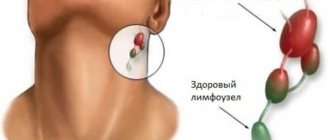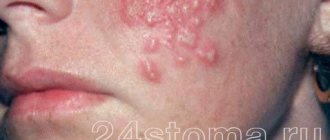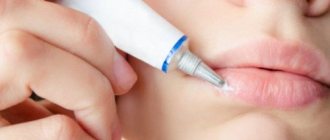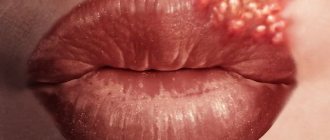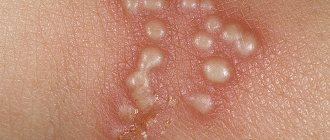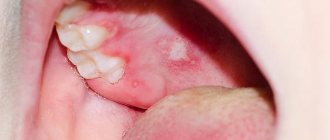Pediatrician Mikhail Nikolsky: Herpes - to treat or not to treat
Alexandra Petrovskaya: Good afternoon. This is a program for the biggest ones. With us in the studio is pediatrician and candidate of medical sciences Mikhail Nikolsky. Mikhail Andreevich, hello.
Mikhail Nikolsky: Good afternoon.
A.P.: We have gathered here today about your scientific work on herpes types 6 and 7. Let's try to explain to the listeners what it is, and, most importantly, where these types come from, and what other types - the first, second, third and so on - go up to 6 and 7.
M.N.: In total, there are 8 or 9 types of herpes, depending on how you count. The first and second types are common herpes, which causes cold sores on the lips. The third type is the herpes zoster virus, which causes chickenpox or shingles in adults.
A.P.: So what we call chickenpox is, in fact, the same herpes?
M.N.: Not the same, it’s a completely different herpes, but also herpes.
A.P.: By what principle are they all united under this name?
M.N.: It's difficult. When scientists studied the DNA of these viruses, it turned out that they all had similar related features. The fourth type, Epstein-Barr virus, causes infectious mononucleosis. The fifth type is what everyone knows as cytomegalovirus. These are also often infections, mostly for children.
And finally, type 6 and 7 are what I do. Most often they cause roseola in children - a three-day fever or sudden exanthema. Next comes the eighth type of herpes, it occurs in Kaposi's sarcoma. This is a serious disease that predominantly occurs in HIV-infected patients.
A.P.: Besides the common name and some similarities in DNA, what else unites them? Maybe there are common methods of therapy or similar effects of the virus on the body?
M.N.: Firstly, unlike many other viruses, there is a medicine against herpes. This is what makes these viruses different from others in many ways because there are no cures for a huge number of viruses.
A.P.: What about all these fashionable antiviral drugs that are advertised everywhere?
M.N.: Everything that is advertised on TV is, unfortunately, most likely fake.
A.P.: Fakes are prohibited.
M.N.: Fakes are prohibited, but, apparently, advertising of drugs without proven effectiveness is allowed.
A.P.: This is a topic for a separate program.
M.N.: This is a problem for our country, because in our country fakes have even found their way into clinical recommendations. And we treat people with all these “bullshit drugs.” Moreover, we are obliged to treat them, because we have appropriate clinical recommendations.
A.P.: Is someone lobbying for this?
M.N.: Of course, this is lobbied for, it is paid for. And what to take if, excuse me, we have one of the members of the Russian Academy of Sciences - a homeopath.
A.P.: In these words you can feel your contempt for homeopathy.
M.N.: From the point of view of a clinical physician, to some extent, yes, contempt, this is true.
Let's return to herpes. They have a unique feature. After a person becomes ill with a primary herpes infection, these viruses do not leave the human body. All herpes that a person encounters in life remain with him forever.
A.P.: I came across the statement that it is difficult to meet a person on Earth over 10 years old who does not have antibodies to one or another type of herpes.
M.N.: And not only antibodies, but even the herpes themselves. In almost all people after a certain age, one or another herpes can be found in saliva, blood or other tissues. This is the problem with diagnosing them - doctors very often get confused. Colleagues, out of ignorance, but with the best intentions, prescribe, for example, saliva tests for frequently ill patients for the Epstein-Barr virus, cytomegalovirus, herpes type 6, type 7, and find them in the saliva. And this is the norm.
A.P.: Are they starting to treat?
M.N.: Yes, absolutely right. The patient does not know that this is the norm. He sees that he has a “terrible” test, that such and such a number of these herpes have been found, and the doctor, most likely, out of ignorance and lack of understanding of this problem, begins to treat normal carriers of herpes. And what does he treat? He treats with the same fuflomycins. And nothing happens.
A.P.: Bottom line – there is no need to treat herpes?
M.N.: It is necessary if it caused a serious illness - and all herpes in certain cases can cause serious illnesses. For example, herpes type 6 is a common cause of severe conditions in patients after a bone marrow transplant. If herpes after a bone marrow transplant has worsened against the background of a decrease, the actual destruction of one’s own immunity, then therapy necessarily requires powerful antiviral agents.
Well, take chickenpox – it would seem a harmless disease. But after 11 years it is difficult and can have consequences. Therefore, it is believed that if the patient is under 11 years of age, it often goes away on its own. And if you are over 11 years old, then it is better not to risk it, but to prescribe acyclovir.
A.P.: Is this a drug with proven effectiveness?
M.N.: Yes, it acts specifically on the chickenpox virus.
A.P.: It turns out that herpes, which is always in the body, at some point gets worse. For example, I heard about herpes type 6, that this is a typical disease for children under 2-3 years of age. It turns out that no.
M.N.: The fact is that herpes type 6 is the most common infection that always causes sudden exanthema or three-day fever or roseola. In principle, it is a very understandable infection: the child has a high fever for three days, then a typical maculopapular rash appears. Within two days it disappears on its own and the person recovers.
The infection itself can occur even through an ordinary kiss, as happens with many herpes. That is, the virus can enter the child’s body through contact with the saliva of the mother, grandmother, or any adult, who are usually the carrier of all herpes. And so the child suffers this primary infection through the human herpes virus type 6, and after that the human herpes type 6 remains in this child forever. And it won’t go anywhere, and there’s no way to get rid of it.
But it needs to be treated only in one situation - if it has caused some kind of serious illness, which almost never occurs in healthy people. Only for severe immunodeficiencies, which usually occur during organ and tissue transplantation. There are situations when intensive treatment of herpes type 6 is required.
In all other cases, there is no need to shock-treat it. And we must keep in mind that herpes is a very fashionable topic now. Herpes virus type 6 is easy to find, which means it can be presented for almost any disease as a possible diagnosis. And many doctors use this. For example: “I don’t know what’s wrong with you. Let’s look for what you definitely have.” And here is herpes type 6 - it definitely exists, and it is there.
A.P.: Another such moment. What other diseases can be associated with herpes viruses that are present in the body?
M.N.: As I already said, herpes types 6 and 7 “classically” cause roseola in children. Herpes type 6 and sometimes, but rarely, type 7 are also associated with febrile seizures in children. There are studies that show a connection between certain types of epilepsy and human herpes virus type 6. So it turns out that herpes type 6 actually causes a type of epilepsy.
A.P.: This virus is present in almost everyone’s body, but not everyone has epilepsy. That is, this suggests that there is no direct connection; there are other factors influencing the appearance of this disease?
M.N.: Of course, there are many factors here. For example, two people caught the same infection: but one had a runny nose, and the other had meningitis. But the infection is the same. Of course, there are many factors involved.
There was also a study that associated human herpes viruses 6 and 7 with other diseases, suggesting a link with multiple sclerosis. But this has not been proven. This is already a field of science, but we do not have clear indications that herpes is exactly what causes multiple sclerosis.
A.P.: During the program, we talked briefly about all herpes and outlined all the important points. And, concluding the conversation, I want to return to the beginning. What questions does science face today in this area?
M.N.: By the way, I forgot to say that a special form of human herpes type 6 is the chromosomal integrated form of this virus, when herpes type 6 is introduced into the human chromosome and begins to be inherited by all generations.
Now we have received a grant in St. Petersburg. We conduct free examinations of everyone for certain indications for the presence of chromosomally integrated human herpes type 6. It is precisely the presence of chromosomally integrated human herpes type 6 that may provide links with certain diseases. It turns out that almost 1% of the world's population has a chromosomally integrated virus built into its genome.
A.P.: Okay. Remembering my student years, what hypothesis do you have in this scientific research? If something, then what?
M.N.: We are currently recruiting a reference group, we are looking for people, we are examining them. I personally am now most interested in whether there are clinical manifestations of chromosomal integration of human herpes type 6 in newborns. In my opinion, this is the most interesting concept; no one in the world has yet developed this direction. So far there are preliminary results, but I’m not ready to announce them yet.
A.P.: Our guest was Mikhail Nikolsky, a pediatrician and candidate of medical sciences. Thank you and have a nice day everyone!
Herpesvirus infections in children
Normally, every person is constantly home to a huge number of viruses, fungi and bacteria. Such permanent “residents” of our body include herpes viruses.
There are several species in the herpesvirus family, and they all have one thing in common - once they get into a person, they never leave him. When examining people for infection with these viruses, it turns out that 70.4% have herpes viruses type 1-2, 97.9% have varicella zoster (varicella zoster virus), 95% have cytomegalovirus, 97.5% have herpes virus type 6 , 95% have Epstein-Barr virus.
Primary infection with herpes viruses occurs in early childhood. Sometimes the virus enters the body asymptomatically, and sometimes it is accompanied by a clinical picture characteristic of the virus. Depending on the reactivity of the body and the state of its immunity, the disease can be quite severe.
Thus, the primary acute disease caused by type 1 herpes viruses is characterized by severe damage to the oral mucosa. The child has a high temperature for several days, he refuses to eat, intoxication is severe, painful ulcers appear in the mouth, the submandibular and cervical lymph nodes become enlarged and painful. Improvement may occur only by 5-7 days, and in some children recovery may take up to 2-3 weeks. In the future, under unfavorable conditions, the virus can rear its head again (recur), but its manifestations, as a rule, are not so severe - most often these are blistering rashes on the lips, which are popularly called a “cold.”
The chickenpox virus (Varicella zoster) also belongs to the herpesvirus family.
When meeting him, the child gets chickenpox. After this, immunity to the virus is developed, a person should no longer get chickenpox a second time (repeated cases of infection are extremely rarely diagnosed), but the virus does not completely leave the body, but remains dormant in the nerve ganglia. When the immune system is weakened (usually in older people), this viral infection recurs in the form of herpes zoster. Bubble elements appear on the skin along the peripheral nerves and in half of the cases along the intercostal nerves. The rash covers the torso like a belt (the word “zoster” in Greek means belt). This condition is accompanied by severe pain - neuralgia and, sometimes, general intoxication.
Herpes virus type 6 during primary infection can cause an acute infectious disease in a child, called sudden exanthema (infantile roseola, sixth disease). First, a high temperature occurs, which lasts an average of 3 days. In most cases, there are no catarrhal symptoms, only slight redness in the throat. Then, as the temperature drops, a red spotty rash appears, which lasts 1.5-2 days and disappears. If the child also received an antibiotic, this rash may be mistakenly regarded as a drug rash. Complications are rare. When the virus enters the latent stage, it most often does not manifest itself in any way. But its involvement in some diseases (for example, chronic fatigue syndrome) is discussed.
Cytomegalovirus and Epstein Barr Virus. Most often they quietly settle into the body, but sometimes in children they manifest themselves as a disease such as Infectious mononucleosis. It can be difficult. There is prolonged high fever, generalized enlargement of the lymph nodes, and especially the lymph nodes of the neck. They grow so large that they visually deform the neck, but they hardly hurt. Other lymphoid formations, such as tonsils and adenoids, also greatly increase. Because of this, the child cannot breathe through his nose and snores at night. Plaques, most often filmy, may appear on the tonsils. The liver and spleen may become enlarged, and sometimes a rash and jaundice may appear.
After suffering any of the above infections, during examination, blood tests determine antibodies specific to the specific virus involved in the disease. Only a doctor can interpret test results. And if the antibodies are positive, this does not mean that the infection is alive, and we must continue to fight it. Most often, this is a memory of an encounter with the virus, and only a doctor can tell you whether it is still active or not.
No need to treat tests! It is necessary to treat the child if his condition requires it.
In each specific case, the doctor will prescribe treatment; sometimes hospitalization is required due to severe infection.
The parents' task is to consult a doctor in time.
And after recovery, follow certain rules so that the immune response is adequate and the infection no longer rears its head.
After an infection, the child’s immune defense remains reduced for a long time and he needs:
- avoid contact with other infectious patients, hypothermia and overheating for about 3 months;
- if necessary, medical withdrawal from vaccinations is recommended;
- It is advisable to follow an antiherpetic diet.
The anti-herpes diet is based on the ratio of two essential amino acids - arginine and lysine.
Lysine suppresses herpes viruses, arginine promotes their reproduction. Products rich in lysine: milk, curdled milk, fermented baked milk, cheese, cottage cheese, yoghurts containing live bacteria, potatoes, fish, pork, vegetables, white chicken, soybeans, lentils, brewer's yeast.
Arginine: chocolate, sugar, raisins, sesame seeds, seeds, nuts (especially peanuts), cereals, wheat bread, oranges and tangerines.
Be healthy!
about the author
- Dobrelya Ekaterina Alexandrovna
- Pediatrician, infectious disease specialist of the highest category. Head of outpatient department No. 2
- All publications by the author
WHAT YOU NEED TO KNOW ABOUT HERPES SIMPLE
Key Facts
There are two types of herpes simplex virus: herpes simplex virus type 1 (HSV-I) and herpes simplex virus type 2 (HSV-II).
HSV-I herpes on the lips and facial area
transmitted primarily through oral contact and causes oral herpes (symptoms of which may include a “fever sore”), but can also cause genital herpes.
HSV-II herpes in the genital area
is one of the sexually transmitted infections and causes genital herpes.
More than 90% of the world's population are carriers of the herpes virus. Infection with both HSV-I and HSV-II lasts for life.
The frequency of herpes on the lips varies from person to person and can recur from 2 to 12 times a year. Most cases of herpes are oral and genital.
Typically, the virus settles in the body at 3-5 years of age, but does not appear until puberty.
Transmission routes:
- Autoinfection.
The virus is transmitted from infected areas of the body to uninfected areas. For example, contact lens wearers can transfer the herpes virus to the eye area by wetting the lenses with infected saliva instead of a solution.
- When contacting another person through a kiss
For infection to occur through a kiss, the virus needs 2 conditions:
so that the carrier has an active phase of herpes (moreover, it can be asymptomatic)
so that the partner has a predisposition to infection: an abundance of saliva, small wounds.
- Upon contact with a contaminated surface
The virus is able to survive for some time outside its host: in a humid environment, at a temperature of 37°. That is, it is possible to become infected by drinking from the same glass or using the same lipstick. It is theoretically possible, but rare, to become infected with genital herpes when sitting on plastic surfaces (toilet, locker room bench), because On plastic surfaces under favorable conditions, the virus survives for about 4 hours.
Stages of herpes
Precursor stage
It usually begins with a tingling, itching and burning sensation on the lips. Duration from several hours to 1 day.
Hyperemia stage
Literally on the same day as the tingling sensation, swelling and redness of the lip occurs. The condition is usually accompanied by itching and lasts on average 1-2 days.
Bubble stage
A group of several bubbles is formed, which merge with each other into one painful bubble filled with lymph. This usually happens on the second day and is accompanied by very painful sensations.
Stage of erosion formation
On day 3, the blisters transform into ulcers and pustules, which then form a sore. Usually it is gray in color with a bright red ring around it. The liquid released from the sore contains virus particles in a concentration of 1 million per 1 ml. and is highly contagious
Crust formation stage
From days 4 to 9, the sore dries out and crusts over. In this case, the pain becomes less, but severe itching appears. The sore may fall off in parts and bleed. Herpes begins to heal from the inside, the sore becomes smaller.
Healing stage
On days 9-11, the wound heals and heals. However, redness may persist for another two days. During this period, the virus returns to a dormant state, in which it can remain until it is activated again by risk factors.
Treatment
The most effective medications for people infected with HSV are antiviral drugs such as acyclovir, famciclovir and valacyclovir. They help relieve symptoms and reduce the frequency of their occurrence, but do not lead to a complete cure.
Prevention
HSV-I herpes on the lips and facial area
HSV-I is most contagious during the onset of oral herpes symptoms, but it can also be transmitted when no symptoms are felt or observed. Individuals with active symptoms of oral herpes should avoid oral contact with others and sharing objects that have come into contact with saliva. They should also abstain from oral sex to prevent herpes from spreading to their partner's genitals. People with symptoms of genital herpes should avoid sexual intercourse while they are experiencing symptoms.
Consistent and correct use of condoms can help prevent the spread of genital herpes. However, condoms can only reduce the risk of infection, since symptoms of genital herpes can appear in areas not protected by a condom.
Individuals already infected with HSV-I cannot become infected again, but they remain at risk of infection with HSV-2, which affects the genital area.
Pregnant women with symptoms of genital herpes should inform health care providers. Preventing new infections with genital herpes virus is especially important for women in late pregnancy, since this is the period when the risk of developing neonatal herpes is highest.
HSV-II herpes in the genital area
People with a genital infection caused by HSV should abstain from sexual activity while symptoms of genital herpes appear. HSV-II is most contagious when lesions appear, but it can also be transmitted when no symptoms are felt or observed.
Systematic and correct use of condoms can help reduce the risk of spreading genital herpes. However, condoms provide only partial protection because HSV can be found in areas not protected by a condom. Medical male circumcision can provide men with lifelong partial protection against HSV-II, as well as HIV and human papillomavirus (HPV).
Individuals with symptoms suggestive of genital HSV infection should be tested for HIV infection, and those living in areas with high HIV prevalence should be offered more focused HIV prevention interventions, such as pre-exposure prophylaxis.
Pregnant women with symptoms of genital herpes should inform health care providers. Preventing new infections with genital herpes virus is especially important for women in late pregnancy, since this is the period when the risk of developing neonatal herpes is highest.
When fatigue is a sign of herpes...
Herpes virus type 6 (HHV-6 or HHV-6) was discovered back in 1986. In 2012, a sensational discovery occurred: it turns out that the herpes virus type 6 in adults may not manifest itself in any way, but can still cause a painful condition
Where does it come from?
According to various sources, about 80% of people are infected with herpes virus type 6. Most often, the infection occurs in early childhood - between the ages of 6 months and 2 years. This is due to the child’s loss of maternal immunity and the high prevalence of the virus. The first meeting can occur in the form of roseola - a sharp increase in temperature, after which a rash appears after 3-4 days. This is the only specific manifestation in children that can be used to suspect HHV-6.
Alas, once in the body, any herpes virus will not leave it. In most people, the immune system quite successfully suppresses the development of herpes virus type 6. Continuing to live in the body, but does not affect anything. But this does not happen for everyone.
Always exhausted
Chronic fatigue syndrome (CFS) has long been considered an independent disease. This is not the kind of fatigue that can be “cured” by vacation, a change of job, or just normal sleep. CFS is diagnosed when a person experiences persistent fatigue and a 50% or more decrease in performance for 6 months or more. In this case, there are signs of chronic infection: low-grade fever, enlarged lymph nodes, muscle and joint pain, chronic pharyngitis, headaches.
Sleep disturbances, depression, irritability, difficulty concentrating, memory and intelligence deterioration often occur. Sometimes appetite disappears, a person suddenly loses or gains weight, problems arise in the stomach, intestines, and urinary system. Moreover, allergy symptoms or sensitivity to bright light, alcohol, medications, etc. may appear.
Before receiving a diagnosis of chronic fatigue syndrome, a person must undergo examination to rule out other diseases. Often the only objective sign of infection is the identification of herpes type 6
How to find out?
At the stage of making a diagnosis or to clarify it, doctors prescribe a laboratory test Antibodies to the herpes virus type VI (Herpes simplex virus VI), IgG. You can take it yourself if you are concerned about decreased performance, and then consult a doctor. For him, it is enough to donate blood in the laboratory 3 hours after eating or in the morning on an empty stomach.
Any decrease in immunity can trigger HHV-6 to become active. Most often it is triggered by stress, flu, or exacerbation of a chronic infection. Often people associate a tired-depressive state with a consequence of illness or stress, but in fact they have become a trigger for the activation of the virus. The active virus lives and multiplies at the expense of lymphocytes - the main cells of the immune system. Therefore, symptoms of infection and damage to the nervous system, which is closely related to the immune system, arise. When the HHV6 virus is activated, it can be detected by PCR in oropharyngeal scrapings or in urine. If there are skin rashes and fever, then herpes virus type 6 can be detected in the blood.
Who will need it?
Doctors identify several groups of patients who need testing Antibodies to the herpes simplex virus VI, IgG, or detection of herpes viruses in an oropharyngeal smear. These are the people who are concerned about:
- memory problems, inability to concentrate on business;
- causeless pain and sore throat;
- soreness of the lymph nodes in the neck and under the ears for an unknown reason;
- muscle pain not associated with physical activity;
- joint pain that has no objective cause (trauma, osteochondrosis, etc.);
- headaches that have never happened before;
- sleep problems;
- weakness and exhaustion after physical activity, clearly not corresponding to the expenditure of effort;
- frequent colds
- feeling of fever or chills at normal temperature
How to treat?
Antiviral drugs for other types of herpes can also be effective for HHV6 infection; the choice of treatment available in Russia is up to the attending physician (different antiherpetic drugs are registered in different countries). Therefore, symptomatic treatment plus boosting immunity is mainly carried out.
Despite all this, type 6 herpes virus is not a death sentence. You can live with it once your immune system can get it under control. Surprisingly, a healthy lifestyle can be of great help in this regard. It is imperative to improve your sleep: for those who sleep less than 6 hours a day, the risk of developing CFS is several tens of times higher.
Get tested on time, and treatment will be the least expensive!
